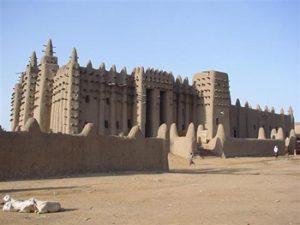
West African history – Niger River, West Africa
Early West Africa
People have been living in West Africa for tens of thousands of years. There are several good-sized rivers – the Niger, the Senegal, and the Volta – that run through West Africa, which make it easier to travel because you can use boats.
Early African history
African environment
African ships and sailing
All our Africa articles
There are fish in the rivers which are good to eat. These rivers also, when they flood, spread good silt all over the land, which makes the land good for growing plants. The rivers do also breed the mosquitoes that carry yellow fever and malaria, but people living in West Africa gradually developed some immunities to these diseases.
What is yellow fever?
What is malaria?
Nok people

Nok sculpture from West Africa, about 500 BC (The Barakat Gallery)
About 1500 BC, the Nok people were living in small villages and farming millet in what is now Nigeria. They made pottery to cook in.
History of millet
Early African architecture
Early African pottery
Starting around 900 BC, traveling craftsmen made small terracotta (clay) statues. Probably these statues were like tombstones to put on top of people’s graves.
But Nok farming methods wore out the land. By around 400 BC, the Nok were moving on to new places.
Iron in West Africa
A blacksmith in Mali
West African Ife (Yoruba) people in Nigeria were smelting iron and making glass beads by around 300 BC, using pot bellows and skin bellows.
History of iron
Who invented glass?
What is a bellows?
Nobody knows for sure whether people in West Africa invented this process themselves, or learned about it from North African or Sudanese blacksmiths.
West African history: Bantu expansion
Around this same time, some West African people, maybe from a little further east in modern Cameroon, were beginning to leave West Africa and travel east, across the African grasslands south of the Sahara Desert, and south-east through the rain forests.
Central African history
History of money
Maybe this was because climate change was making the Sahara drier, and there were too many people squeezed into West Africa. Maybe they were just looking for new farmland.
The migrants probably didn’t all leave at once, but in small groups, now and then, moving gradually through eastern and then southern Africa. We call these travellers the Bantu, which means “people” in their languages. The Bantu’s iron weapons may have helped them to force their way into the communities they met. Or maybe they gave their new neighbors presents of iron hoes and glass beads. In those days, people used glass beads as a kind of money.
The Bantu reach South Africa
By 400 AD these Bantu people had reached South Africa, where they began to marry some of the Khoikhoi and the San people. Some people in South Africa began farming or keeping sheep or cattle around this time; others, who wanted to remain hunters and gatherers, were forced off the best agricultural land and into the deserts.
Djenne-Djeno

Mosque at Djenne, Mali, built about 1200 AD (around the time of Sundiata)
But many Bantu people also stayed in West Africa. They started to form bigger kingdoms and empires.
Around 250 BC, there was a powerful kingdom at Djenne-Djeno, in modern Mali, far up the Niger river in West Africa. Soon Djenne-Djeno traders were sailing along the Niger river trading for iron and good basalt stone to make grindstones.
What is basalt?
By 500 AD, they were also working copper, which came north from more than 600 miles (1000 km) further south in Cameroon.
History of bronze
What is copper?
Djenne-Djeno traders sold their pottery all up and down the Niger river. By this time, there were about 20,000 people living in Djenne-Djeno. There were also smaller towns around the main town.
Ghana Empire
A little later, about 400 AD, an even bigger empire formed as the Ghana Empire united western Mauretania and eastern Mali. (No, that’s not where the modern country of Ghana is!)
Where do camels come from?
History of gold
Why is salt so important?
Using the new camel caravans to cross the Sahara Desert, the Ghana Empire acted as a middleman, selling gold from further south to North Africa in exchange for salt. They also traded with the Djenne-Djeno kingdom to their south-east. The Ghana Empire maintained an army of 20,000 archers.
Who invented bows and arrows?
The Fulani come to West Africa
About this same time, maybe fleeing the Vandal invasion of North Africa, people from Morocco and Mauretania – from the old Roman Empire – began to migrate south into the Ghana Empire and then further south along the Atlantic coast. They married West Africans and became known as the Fulani.
Roman North Africa
Who were the Vandals?
Did you find out what you wanted to know about West African history? Let us know in the comments, or go on to medieval West Africa!
Learn by doing: eating West African food
Medieval West Africa
Bibliography and further reading about early West African history:
And more recent research about the Nok